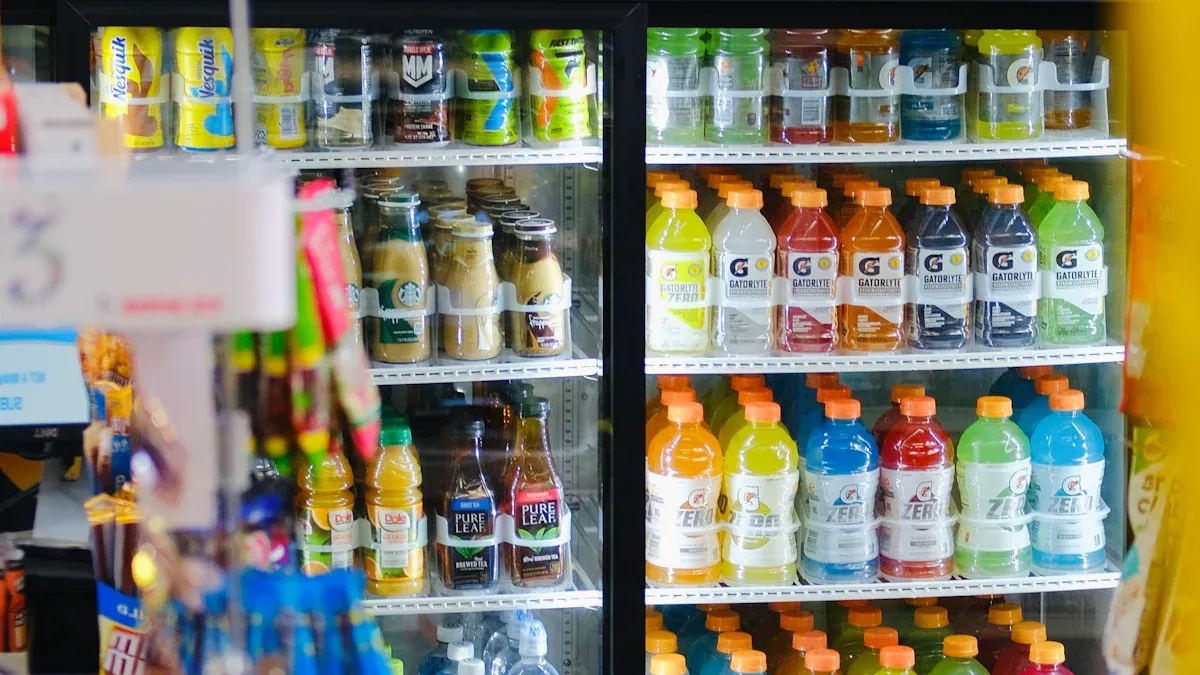Ai driven planogram optimization in retail

You want faster results and better profits in your stores. AI-driven planogram optimization lets you achieve that. You can move from weeks of manual planning to quick, data-powered decisions. The following table shows how much time you save when you switch to AI:
Aspect | Manual Process Time | AI-Powered Process Time | Time Savings |
|---|---|---|---|
Planogram Creation | Weeks | Minutes | Significant |
Dynamic Updates | N/A | Real-time | N/A |
Consistency Across Stores | N/A | High | N/A |
With AI, you gain more control, speed, and accuracy. This means better shelf layouts, fewer errors, and more sales every day.
Key Takeaways
AI-driven planogram optimization saves time, reducing weeks of manual planning to just minutes, allowing for faster and more accurate shelf layouts.
Real-time data integration with POS systems enables retailers to make informed decisions about product placement, improving sales and customer satisfaction.
Automation of planogram updates allows staff to focus on customer service rather than manual checks, leading to a more efficient store environment.
AI tools can enhance compliance across stores, quickly identifying errors and ensuring that products are always in the right place, which boosts overall sales.
Implementing AI solutions requires a readiness assessment, integration with existing systems, and proper training to maximize benefits and improve store performance.
Planogram optimization challenges
Manual processes
You face many obstacles when you rely on manual planogram optimization. Creating and updating planograms by hand takes a lot of time and effort. Employees may not have the right skills or knowledge, which can lead to mistakes. Costs for software, training, and resources can also slow you down. Limited shelf space and frequent product changes make it even harder to keep up. The table below shows some common challenges:
Challenge Type | Description |
|---|---|
Data Accuracy | Developing planograms requires reliable sales data and customer trends, which can be difficult to gather manually. |
Human Factors | Employees may lack the necessary skills or knowledge to implement planograms effectively. |
Economic Constraints | Costs associated with software, training, and resources can hinder the implementation process. |
Logistical Complexities | Limited shelf space and frequent product changes complicate the adherence to planograms. |
Manual methods often lead to poor execution, lost revenue, and compliance penalties. You may also experience delays in audits and inefficiencies in identifying out-of-stock items.
Data limitations
You need accurate and complete data for effective planogram optimization. Many retailers struggle with outdated technology that cannot process complex data. Employees may not have the skills to interpret large data sets. Sometimes, your team resists new technology, making it hard to improve your process.
Outdated IT systems limit your ability to analyze sales and inventory.
Skill gaps make it hard to turn data into action.
Merging data from different sources is complex and time-consuming.
Without strong data governance, you risk errors and inconsistencies.
These data limitations can prevent you from making the best decisions for your store layout.
Compliance issues
You want every store to follow your planogram guidelines, but this is not easy. Without real-time data, you cannot quickly spot and fix problems. Poor communication between brands and retailers can cause confusion about product placement. Staff may not fully understand the guidelines, leading to errors on the shelf. You may also see big differences in how each store follows the plan.
Lack of real-time data leads to missed stockouts and poor shelf planning.
Poor communication causes mistakes in product placement.
Staff may not know the rules, so they make errors.
Inconsistent execution across stores weakens your overall strategy.
These compliance issues can hurt your sales and make your stores look less appealing to customers.
AI in planogram optimization

Data-driven insights
You can use AI to turn your sales data into powerful insights for planogram optimization. AI connects with your Point of Sale (POS) systems and pulls real-time sales numbers. This helps you see which products sell best and where you should place them on your shelves. AI also looks at shopper preferences and past sales to predict what your customers will want next. This means you can adjust your displays before trends change.
Aspect | Description |
|---|---|
Integration with POS Data | AI uses real-time sales data from POS systems to inform planogram design, enhancing alignment with sales performance. |
Data-Driven Merchandising | Analyzing sales data and shopper preferences helps you optimize product placement for visibility and sales. |
Predictive Analytics | AI predicts customer behavior using past sales data to optimize product placement in planograms. |
AI-driven image recognition takes this a step further. You can use photos of your shelves to check if products are in the right place. The technology finds and locates each item, making sure your planogram matches what is actually on the shelf. This keeps your stores consistent and helps you spot mistakes fast.
AI-driven planogram management lets you monitor shelves in real time and fix problems right away.
You can reduce shelf organization errors by 90% and cut manual inventory checks by half.
Better product placement leads to higher sales and happier customers.
Automation
AI brings automation to planogram optimization, saving you time and effort. You no longer need to update planograms by hand. AI creates store-specific layouts that change as your inventory changes. This means your shelves always match what your customers want.
AI creates and updates planograms for each store based on real-time inventory.
Automation lets you manage more planograms across different categories, boosting sales.
AI-powered solutions use data to make smart choices about where to place products.
You can cut the time and resources needed for planogram updates across all your stores.
Algorithms adjust planograms as soon as new data comes in.
Improvement Metric | Percentage/Factor |
|---|---|
Improvement in efficiency | 50% |
Automation of planogram creation | Up to 95% |
Reduction in category reset cycle times | 3X |
Improvement in product availability | Measurable |
With automation, your staff can focus more on helping customers instead of fixing shelves. You also get better compliance because AI keeps your planograms up to date.
Real-time adjustments
AI gives you the power to make real-time changes to your planograms. You can respond to sales trends, local events, or even sudden changes in inventory. AI-powered vision technology checks your shelves and sends alerts if something is wrong. You get instant updates about stock outs or compliance problems.
AI vision technology provides real-time data for dynamic planograms.
You get instant alerts for stock outs and compliance issues.
The system uses consumer interaction data to suggest better product placements.
Automated reporting and analytics help you adjust planograms quickly.
You can react to seasonal changes, local preferences, and promotions right away.
AI-powered tools like Quant and LEAFIO help you keep your planograms accurate and up to date. These tools use photo-based shelf audits, instant compliance reports, and dashboards to track every store. You can see which stores need attention and fix problems fast.
Feature | Description |
|---|---|
Photo-Based Shelf Audits | Store staff capture shelf photos using the app, which are analyzed against the approved planogram. |
Instant Compliance Reports | Provides real-time validation on product placement and out-of-stock situations. |
Auto-Flag Gaps and Errors | Automatically detects and flags incorrect SKUs and empty shelves for corrective action. |
Seamless Dashboard | Allows managers to track compliance across stores with visual proof, minimizing physical visits. |
Tip: Real-time planogram optimization helps you avoid lost sales and keeps your stores looking their best.
You can achieve up to a 30% improvement in planogram compliance within two months by using these AI-powered tools. Real-time alerts and guided execution make it easy for your team to follow the right plan, no matter where they are.
Applications and results

Improved placement
You can use AI-driven planogram optimization to improve product placement in every store. AI analyzes customer behavior, sales history, and market trends. This helps you decide where to put each product for maximum visibility. You can see the difference in many retail formats. Supermarkets use AI to organize large assortments and automate replenishment. Convenience stores focus on quick access to popular items. Specialty shops highlight unique products to create a better shopping atmosphere.
Application | Description |
|---|---|
Real-time data analysis | AI reviews customer actions and sales to recommend product placement. |
Dynamic layout adjustments | You can change layouts quickly to boost product visibility. |
Precision in product localization | AI ensures products are in the right spot, improving compliance. |
You can detect if products are in the correct order, check facing counts, and flag missing SKUs. This leads to better shelf management and fewer mistakes.
Sales and labor impact
You will notice strong results after using AI-driven planogram optimization. Retailers report sales increases of 10–30% in test locations. Well-designed displays can boost sales by up to 540%. AI helps you reduce stockouts by up to 80%. You can also save up to 40% on labor costs because AI automates shelf audits and planogram updates.
Store Type | Strategy Description | Sales Impact |
|---|---|---|
Urban | Optimize for commuter rush hours with premium drinks | 10–30% sales lift |
Suburban | Prioritize family-size packs for weekend sales | 10–30% sales lift |
Rural | Focus on soft drinks and bulk items for longer trips | 10–30% sales lift |
AI-driven forecasting and smart inventory tools can reduce excess inventory by up to 35%. You can shorten reorder cycles and keep shelves stocked with popular items.
Tip: AI-powered compliance monitoring helps you spot planogram violations quickly, preventing missed sales.
Customer experience
You can create a better shopping experience for your customers with AI-driven planogram optimization. AI places products where shoppers can see them easily. Customers find what they need faster. AI can personalize displays by analyzing shopper data. This makes each visit more enjoyable. You can adjust layouts in real time to match current trends and sales data. Inventory management becomes easier, so popular items stay in stock.
Improved product visibility helps customers find items quickly.
Personalized shopping experiences make each visit special.
Real-time adaptability keeps your store fresh and relevant.
Streamlined inventory management ensures customer satisfaction.
You can see these benefits in every store format. Supermarkets encourage movement by placing essential items in key spots. Convenience stores offer quick access to bestsellers. Specialty shops create a comfortable atmosphere by highlighting unique products.
Implementation steps
Readiness assessment
You should start with a readiness assessment before you adopt AI-driven planogram optimization. Check if your data is complete and accurate. Make sure your team understands the goals and benefits. Look for any gaps in your current process. Overcomplicated design processes can cause burnout and inconsistency. Staff may not follow planograms if they use personal systems or do not know the rules. Lack of data can lead to poor results.
Obstacle Description | Explanation |
|---|---|
Overcomplicated design processes | Complex steps can cause burnout and errors. |
Failure of in-store staff to execute planograms | Staff may ignore planograms due to habits or lack of awareness. |
Lack of data | Missing data leads to weak planogram optimization. |
Tip: Keep your planograms simple and user-friendly to help your team succeed.
Integration
You need to connect your AI solution with your existing systems. Link your POS systems for real-time stock updates. Use ERP solutions to synchronize data. AI will provide predictive analytics for better product placement.
Integration Component | Function |
|---|---|
POS Systems | Provides real-time stock updates |
ERP Solutions | Ensures seamless data synchronization |
AI | Offers predictive analytics for placement |
You should test the integration to make sure data flows smoothly. This step helps you avoid errors and delays.
Training and measurement
Train your team to read and execute planograms. Involve senior members for consistency. Teach everyone how to use the new system. Do consumer research to design effective planograms. Measure performance often to see what works.
Start simple with easy-to-follow planograms.
Train your team and involve leaders.
Research consumer behavior.
Measure results and adjust as needed.
You can track success using sales by shelf, planogram compliance rate, stock availability, and task completion rate. Use cost-benefit and break-even analysis to measure ROI. Retailers often see a 40% improvement in product placement accuracy and a 3–5% sales lift within weeks.
Note: Regularly analyze outcomes and adjust your planograms to keep improving.
You can boost sales, improve efficiency, and keep stores compliant with AI-driven planogram optimization. Retailers now use digital tools to move away from manual audits and make smarter decisions. The table below shows how this trend fits into the bigger picture of retail digital transformation:
Trend | Description |
|---|---|
Customer-centric focus | Retailers use new solutions to meet shopper needs. |
AI and machine learning | These tools bring automation and real-time updates. |
Digital changes keep you ahead of competitors.
You can create better shopping experiences.
Explore AI solutions or talk to experts to start your journey.
FAQ
What is AI-driven planogram optimization?
AI-driven planogram optimization uses artificial intelligence to design and update shelf layouts. You get real-time data and smart suggestions. This helps you place products where customers will see them first.
How does AI improve planogram compliance?
AI checks your shelves using photos or data. You get alerts if products are missing or misplaced. This helps you fix problems fast and keep every store consistent.
Can AI-driven tools reduce labor costs?
Yes. AI automates shelf audits and planogram updates. Your team spends less time on manual checks. You can focus more on helping customers.
What results can you expect from using AI for planograms?
You can see sales increase by 10–30%. Stockouts may drop by up to 80%. Labor costs can fall by 40%. Your customers find products faster and enjoy a better shopping experience.
See Also
Exploring The Advantages Of AI-Driven Vending Machines
Transforming Online Retail With AI-Enhanced Management Tools
The Future Of Retail Lies In AI-Driven Stores
Understanding The Growth Of AI-Enhanced Corner Stores
Boosting Office Efficiency With Intelligent Vending Solutions
